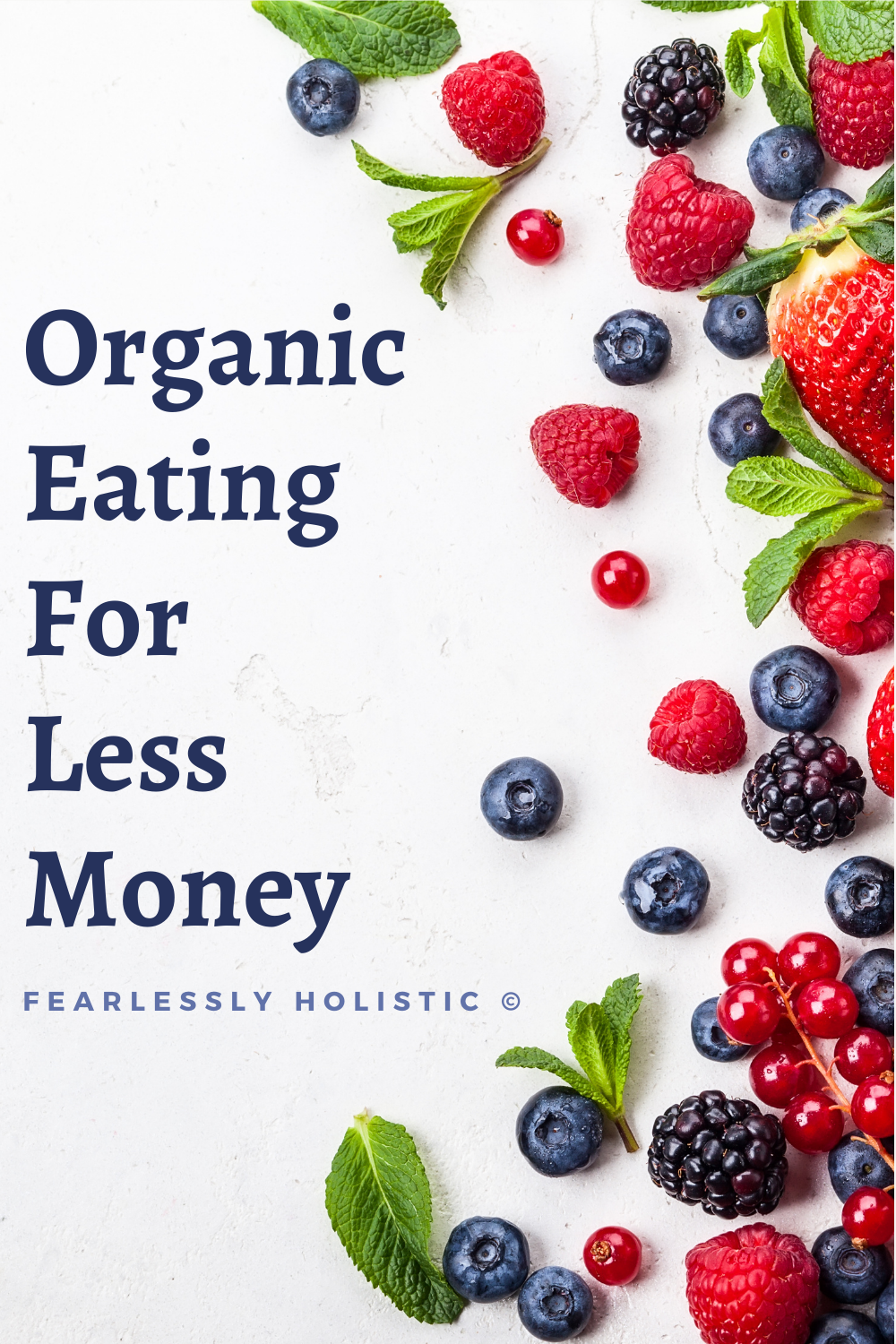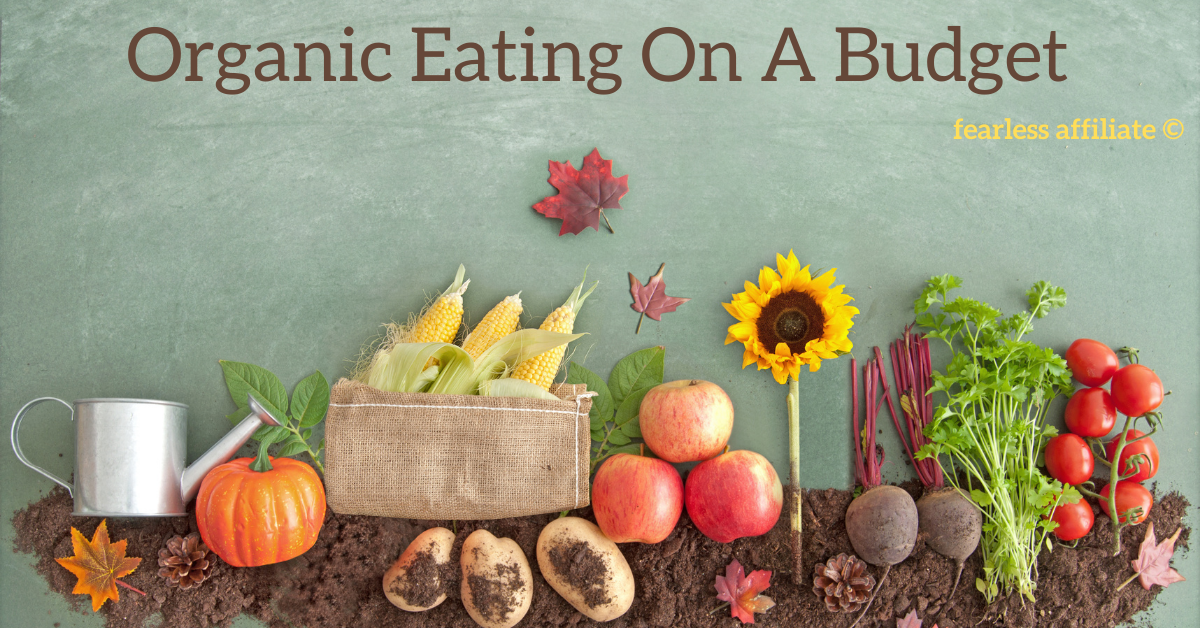Organic eating on a budget is not as hard, or as expensive, as you might think. Today we look at:
- What does organic mean?
- Benefits to eating organic
- How to start eating organic food
- Important tips when you shop for organic foods
- Buying organic while on a budget
When hearing the phrase “living more organically”, many people picture a modern day homesteader.
They’re building their own home from recycled materials, living without electricity, growing their own food free of pesticides and chemicals, and raising and slaughtering their own meat.
While some may go to this extreme, it isn’t necessary to get more organics in your life – and do so without breaking the bank.
Hello and welcome to Fearlessly Holistic.
My name is Irma and I want to share my journey to improved health by eating whole foods, moving my body and eliminating stress as much as possible.
It is my hope to inspire you to make daily changes. Why? Because eating fresh, seasonal food and getting some sunshine is the best way to increase longevity. But you do not want just a long life. You want a quality long life.
My blog posts are my opinion and the results of things that I have tried that either worked for me or didn’t. My opinions are for informational purposes only and are not intended as medical advice. Medical advice should always be obtained from a qualified medical professional for any health conditions or symptoms associated with them. As well, there may be affiliate links in this post. Read more here.
What’s The Definition of Organic?
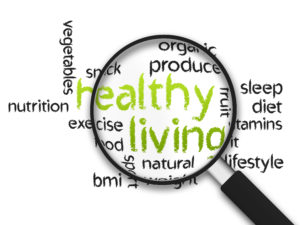
Dictionary.com defines organic as: “Relating to or derived from living matter”.
According to the U.S. Environmental Protection Agency “Organically grown food is food grown and processed using no synthetic fertilizers or pesticides.” (source: http://www.epa.gov/pesticides/food/organics.htm)
But what does that really mean?
Basically clean food grown in healthy conditions.
The healthy conditions mean: tilling leftover plant material (leaves/stalks etc) into the ground to create living soil for the next growing season.
NOT stripping the soil of all nutrients until it is no longer useful for growing food.
As well, no chemical fertilizers are used.
Instead, the process relies on using natural or mechanical methods for pest control; for example, using beneficial insects to control the harmful ones.
When talking in terms of food, especially produce, organic means the food is grown without using synthetic fertilizer, sewage sludge, and irradiation.
These processes would be unnecessary if industrial farming practiced sustainable farming.
It also means that the foods have not been genetically engineered.
In order for food to be certified organic by the United States Department of Agriculture, it has to be grown and processed according to their guidelines.
These guidelines include the soil quality, pest and weed control and use of additives.
A government inspector must approve the growing operation while the grower must go through a certification process.
Everyone who comes in contact with the food, including handlers and processors have to be certified by the government as well.
Home gardeners can grow their own organic produce too.
The USDA has tips to help them get started.
Meat and dairy products sold as organic are from animals that are raised under specific animal welfare guidelines.
They cannot be given antibiotics or any kind of growth hormones. These animals must be provided with access to the outdoors and be fed 100% organic feed.
This feed does not contain any animal by-products or genetically modified (GMO) grains.
Other organic products, such as cleaning supplies, simply means the product contains no toxic chemicals and is made from all natural ingredients.
A resource for determining the safety of household cleaners found in many homes is the Environmental Working Group, online at www.ewg.org.
They rate the safety of almost every over-the-counter brand and product.
When choosing organic cleaning products look at the specific ingredients listed on the label.
It should contain no phosphates, no solvents, or any petroleum-based ingredients.
When you think of organically grown food it’s often viewed as a more environmentally friendly way of producing or growing products.
Since organic food is grown without pesticides, hormones or petroleum-based fertilizers found in most industrial farms, it is a much greener way of producing food.
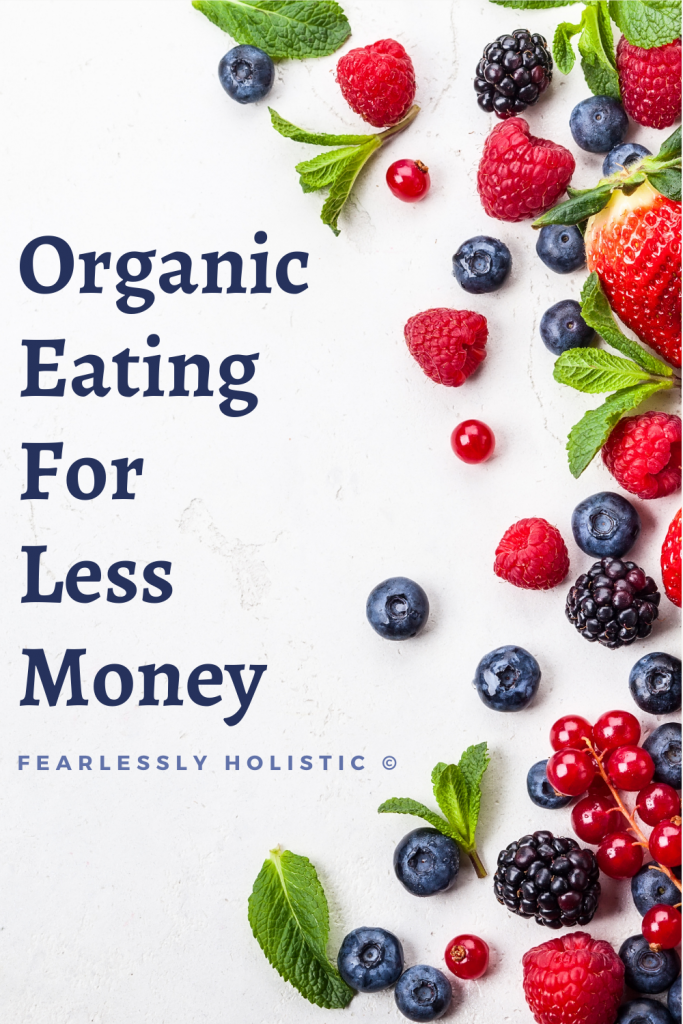
Benefits To Eating Organic Foods
You may be wondering if organic products are healthier or more beneficial than regularly produced or grown products. There isn’t a
definitive answer for that.
Just because something is organic does not automatically make it better for you or the environment.
Nor does “organic” mean they are easier to grow and maintain.
Again, there are guidelines that must be followed.
However, organic food can help you protect your family from toxic pesticide residue that is often found on non-organically grown fruit and vegetable skins.
Here are 9 important benefits to going organic with food:
Is it more nutritious?
Maybe. The answer isn’t clear yet from the studies of the past 50 years. Most will agree, though that the chemicals used in weed and pest control do end up in our soil and eventually into our food.
New research has shown that some organic produce can be lower in nitrates and higher in antioxidants than produce grown traditionally.
Free of Pesticides.
Conventional farming uses synthetic pesticides to protect their crops from insects and diseases. This leaves a residue on the produce and leaks into the soil.
It also causes farmers to continuously clear their land of leftover vegetable matter instead of tilling it back into the soil.
This is causing the eradication of the vital topsoil.
Losing our topsoil means that the dirt is dead. We cannot add the topsoil back once it is gone, and it can take centuries for nature to fix this.
On the other hand organically grown produce growers use insect traps or predator insects as well as disease-resistant varieties of plants to control pests.
Scientists are now discovering that even low doses of pesticide threaten our weight.
These pesticides are hormone disrupters that tamper with the body’s natural weight-loss chemistry.
For example, certain bug-killing organophosphate pesticides are linked to obesity.
No Food Additives.
Organic regulations restrict the use of food additives such as preservatives, artificial sweeteners, colorings, and flavorings as well as monosodium glutamate.
Better for the Environment.
Organic farming is better for the environment because of the way it reduces pollution and conserves water and soil quality.

Taste Better and Truer Flavor
People who eat organic food agree. It just tastes better. Strawberries and tomatoes grown in a natural chemical-free way are sweeter and juicier.
Better yet, these organic foods taste real.
Have you ever had a hard strawberry in winter, with its pure white interior? It tastes more like a potato than fruit.
Avoids Poor Scientific Advancements Food
Scientific advancements like cloned foods, GMOs and rBGH were rushed to market as a way to meet the growing needs of feeding the world.
These scientific modifications have been shown to cause health problems including cancers, tumors and birth defects.
Top GMO foods:
- Corn
- Soy
- Sugar
- Aspartame food additive
- Zucchini and yellow squash
- Dairy products contain growth hormones
- Cotton
- Canola oil
- Papayas.
Higher Levels of Vitamins
Growing organically produces foods that have higher levels of vitamins and minerals. This is due to the products being grown in healthy soil and under more natural conditions.
Benefits Animal Habitats
Organic farming doesn’t disturb the habitats of animals since the foods are grown in a natural way without destroying forests and the surrounding land.
Supports Local Farms
Buying organic produce from your local farmer’s market or farm stand supports the economy in your area.
The benefits of going organic can far outweigh the slightly higher cost of the foods.
The health benefits alone to you and your family can be the deciding factor when choosing between organic and traditionally grown foods.
How To Start Eating Organic Food

Going organic has gained tremendous popularity in the media as well as among foodies and environmentalists.
As you move forward with eating more organic foods, keep these tips in mind. They can help you get more organic food for less money.
Cost.
Organic food can cost more than traditionally grown foods.
In fact, it can cost up to twice the amount of chemically farmed produce. The cost can be offset in several ways though.
For instance, by eating in-season fruits and vegetables.
Plan meals and shop for fruits and vegetables when they are naturally in season, such as strawberries in the spring or tomatoes in the summer.
If possible, buy extra to preserve for use in the off-season.
In-season fruits and veggies are cheaper because there is a lot available at one time (i.e. everyone is selling it). This is the time to freeze or dehydrate, when food is fresh and less expensive.
Finding and Buying Organic products.
Whether you live in a large city or very rural town, finding organic products in the local stores can be a challenge. You may have to drive a little further or search out local farms that carry organic produce and meat.
Check online to find local farms that offer organic products. Here is a link to Local Harvest’s website.
An excellent resource for finding pastured meat in North America is EatWild.com.
I discovered this site about 15 years ago when I was looking for local grass-fed beef. There was one listing for grass fed beef near me.
Now there are many listings because of supply and demand. Win-win for us!
Organic dairy products can be especially hard to find. Read this article from Harmony Organic to understand confusing labeling of organic dairy in case you find some.
Shorter shelf life.
Organics and fresh foods without added preservatives tend to deteriorate quickly.
One way to combat this is to use up fresh products before turning to frozen or canned varieties.
Another option is to freeze whatever you can’t use within a few days. Consider purchasing a food dehydrator. Or, if you have the cash, buy a food freeze dryer and create long-lasting preserved foods.
Understanding labels.
With so many different types of foods and the way they are grown, consumers have to become savvy at understanding labels and the ingredients in products.
For example, does the USDA seal mean something is 100% organic or just that is has fewer chemicals?
You can find a great label tool on the http://www.greenerchoices.org/eco-labels/ site to help you decode food labels.
Buying in season and preserving extra amounts is a way to save on the cost of organic foods so you can enjoy them year round.
Important Tips When You Shop For Organic Foods

When incorporating organics into your life, especially when you’re watching your budget, you need to know what the most important products are to use.
- What foods should you always buy organic?
- Are organic cleaning supplies important?
The “Dirty Dozen Plus” of produce, according to Dr. Andrew Weil are those that have the highest pesticide load. The dirty dozen is updated yearly, as farming practices change.
It’s important to buy the organic version whenever possible.
Veggies that should be organic:
- Cherry tomatoes
- Hot peppers
- Celery
- Kale/collard greens
- Summer squash
- Lettuce
- Spinach
- Sweet bell peppers
- Cucumbers
- Potatoes
Fruits:
- Strawberries
- Grapes
- Peaches
- Nectarines
- Cherries
- Apples
- Pears
Generally, the thicker the skin, the less likely the food will have high pesticide levels. Soft or thin skinned, or if you eat the skin, should be organically grown.
These foods are cleaner and the least likely to be contaminated with pesticides.
Veggies:
- Onions
- Cabbage
- Asparagus
- Broccoli
- Sweet Peas (Frozen)
- Sweet Corn (Frozen) (regular frozen corn is GMO unless otherwise stated)
Fruits:
- Pineapples
- Mango
- Kiwi Fruit
- Bananas
- Avocado
- Papaya
Organic Meat and Dairy
Organic meats should not contain antibiotics. Meat animals should be raised hormone-free.
Livestock are fed all organic feed, which is feed that hasn’t been grown with pesticides or chemicals.
Animals should be raised in clean housing, with rotational grazing, and have a healthy diet.
Livestock and milking cows must graze on green pasture for at least four months a year.
Chickens should have either an enclosed area or be free-ranged so they have freedom of movement, fresh air, direct sunlight and access to the outside.
Other organic products to consider include children’s bedding, clothing and toys especially if you or someone in your home has asthma or other allergies.
These products are made from organic cotton or hemp.
Buying organic can be more expensive but there are ways to reduce the costs.
Shop around and ask others where they find their organic products.
Buying Organic while on a Budget
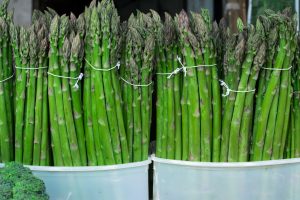
When you’re on a budget, incorporating organics might seem out of reach.
It’s true that organic products are often higher priced than conventional products, but the pricing gap is closing as demand climbs.
But with these tips you can begin using organic products without emptying your wallet.
- Buy fruits and vegetables that are in season when possible. Ask you grocer when the new produce comes in.
- Get fresh produce from your local farmer’s market. One caveat, many farmer’s markets accept food stamps and some even have matching programs so you can double you spending.
- Purchase in bulk when possible. You can freeze or preserve the extra for later so that you don’t pay premium prices in winter.
Read labels carefully. Some organic products also contain excess sugar or starches.
- Look for sales. Sign up for your store’s weekly circular to find out what’s on sale that week. Stock up. Plan your meals around these items as well as what’s in season.
- Don’t be afraid to purchase produce that hasn’t been certified organic. If you talk to the farmer directly, and they say they don’t use herbicides or pesticides, then you can get good organic produce for a cheaper price.
Grass fed beef and free range chickens can be more expensive, but the taste is superior.
Eat organic whenever possible; supplement with local, pesticide free foods (= clean).
- Use your leftovers. Leftover green beans can go in a salad. Leftovers also make a great lunch the next day.
- Make a menu & shopping list before you go shopping. Stick to this list and you’ll have everything you need for meals without a lot of extras.
- If your budget is really tight, buy only what you need for the week.
Shop locally but stay away from the specialty stores.
Costco has organic meat at a reasonable price. For a wide selection of organic produce a local store might be a better choice.
Visit several stores in your area and note the prices & availability of organic options. Keep this list handy so you know where to shop for each item.
Don’t shy away from coupons.
They are harder to come by for organic based products but some can be found online.
Email your favorite companies for a chance to get coupons in the mail.
Determine which products are most important to you to purchase in organic form.
This allows you to spend a little more on them and still get conventional forms for other things at a lesser price.
The best choices, in organic or conventional products, will have very few preservatives, fake sugar, very little or no additive or chemicals.
Cook from scratch.
Make snacks from scratch instead of buying organic prepackaged snacks that can cost as much as $5 a box.

Make homemade fruit leather, Fathead crackers, Keto cereal, more Keto cereal (granola), low carb pretzel dogs (using that multi-purpose FatHead Pizza dough recipe), and danish.
Make several batches at once and freeze part of them for later. Do away with all prepackaged foods.
Take small steps.
If the idea of going completely organic is too expensive, consider purchasing one or two organic products at a time, replacing conventional products for the healthier alternative.
The foods you eat the most frequently should be where you start.
Fruits, vegetables, milk and dairy, meats and baby foods should be top priority. Check the Dirty Dozen list yearly for the important foods to buy as organic.
Certified organic cotton or hemp can replace fabrics such as bed sheets or linens.
Keep in mind that natural fabrics aren’t the same as organic. Natural fabrics have been processed with a variety of toxic chemicals or from plants grown with pesticides.
Grow your own organic vegetables.
Start a compost heap. Use organic or heirloom seeds, natural pest control and chemical-free fertilizer.
You can start off with pots on your patio and advance from there. Try planting a salad garden with your kids.
Choose a chemical-free home
You can make your own or choose organic cleaning products, soaps, lotions, and body care products.
A great place for recipes to make home-made “clean” products (including face masks and hair treatments) is Crunchy Betty. I’ve used her ideas for non-toxic oven cleaner and bathroom cleaner for years now.
These tips can help you stretch your budget and still enjoy fresh healthy foods. By pre-planning, watching for sales and buying local you will be able to add more organic products to your life.
Conclusion
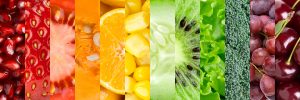
Before you start adding organics to your life you have a little homework to do.
Take some time to research and understand what the different organic labels mean.
Decide which of those labels you want to focus on when buying products and which you don’t.
Search out local farmers and growers who offer organic products to the public.
Local crafts people who sell organic cleaning and body care products can be a big help on your budget.
Lately I am finding many home crafters who make goats milk soaps, coconut oil lotion products (like these from MadeOn. They have the best lotion bars), lip balms, bug block, and bath bombs.
Buy in bulk when possible.
- If you can afford to and have the room, buy a side of grass fed beef to freeze.
- Buy a few extra pounds of organic produce to freeze or preserve for later use.
- Visit local chicken farms to purchase organic eggs and poultry.
Don’t forget the dirty dozen of produce.
If you have to pick and choose, those fruits and vegetables with thin skins are often the best choices for organic.
Adding organic products doesn’t have to cost a fortune.
Being selective and following the above tips will help you enjoy a more organic lifestyle without breaking the bank.
Holistic approaches never just address symptoms of specific health problems, but instead aim to return or keep the patient in a state of balanced health between mind, body, and spirit. Holism targets overall wellness, and when we are well, we only get better with age.
Please share this post with anyone who can benefit from it. Sharing is caring!
And follow me on Pinterest!
Until next time, here’s to our health!
-Irma
